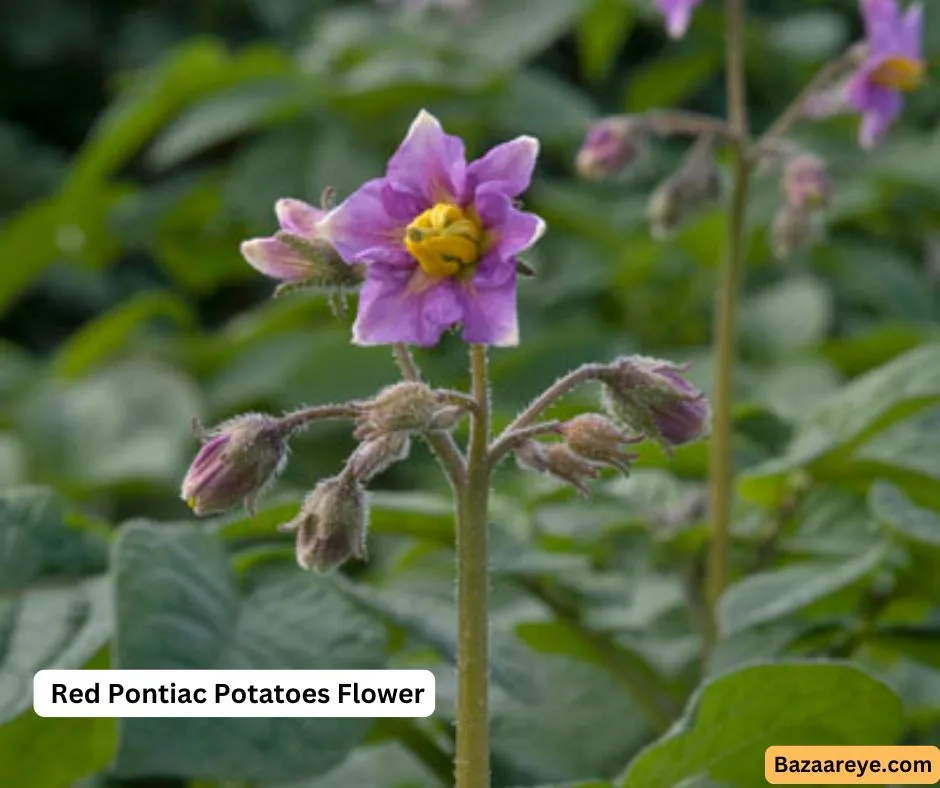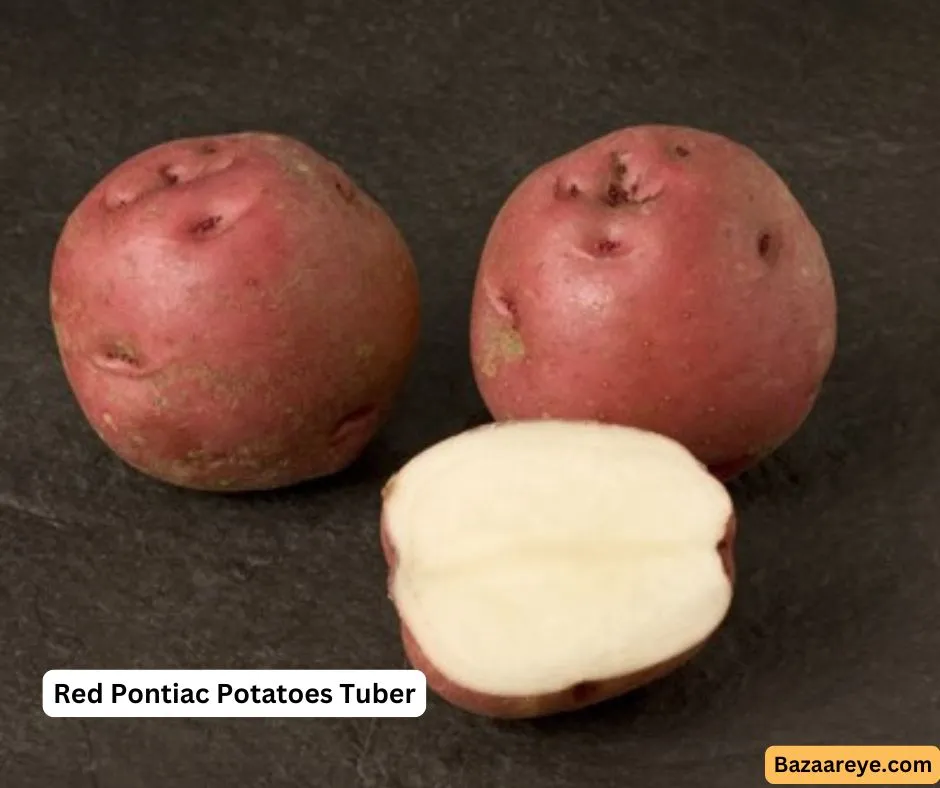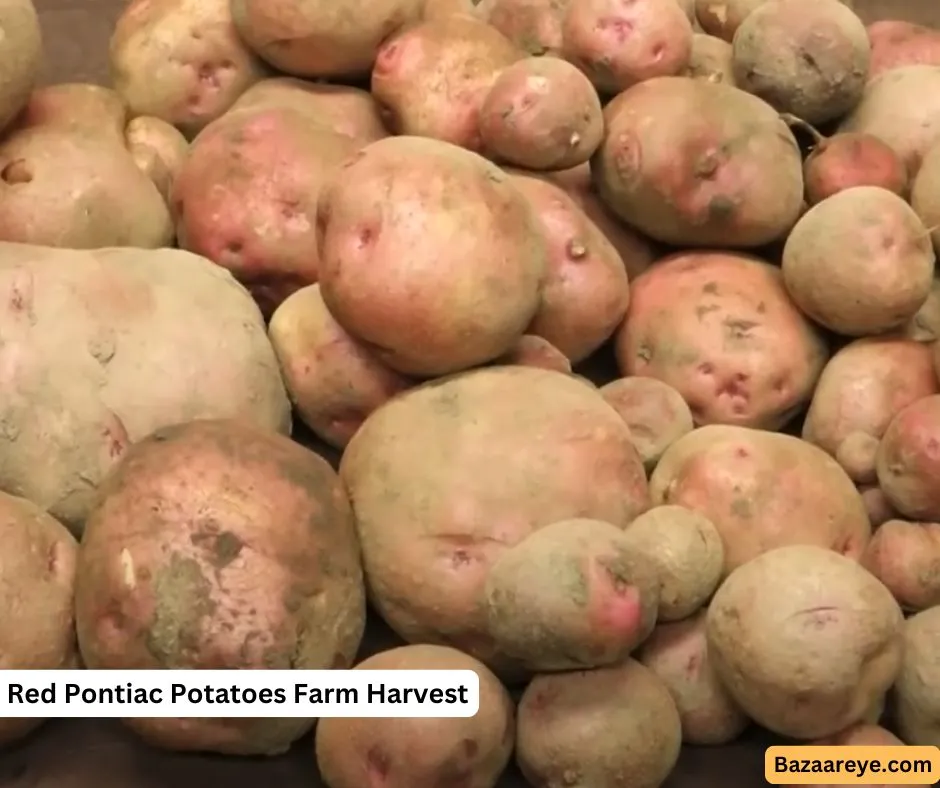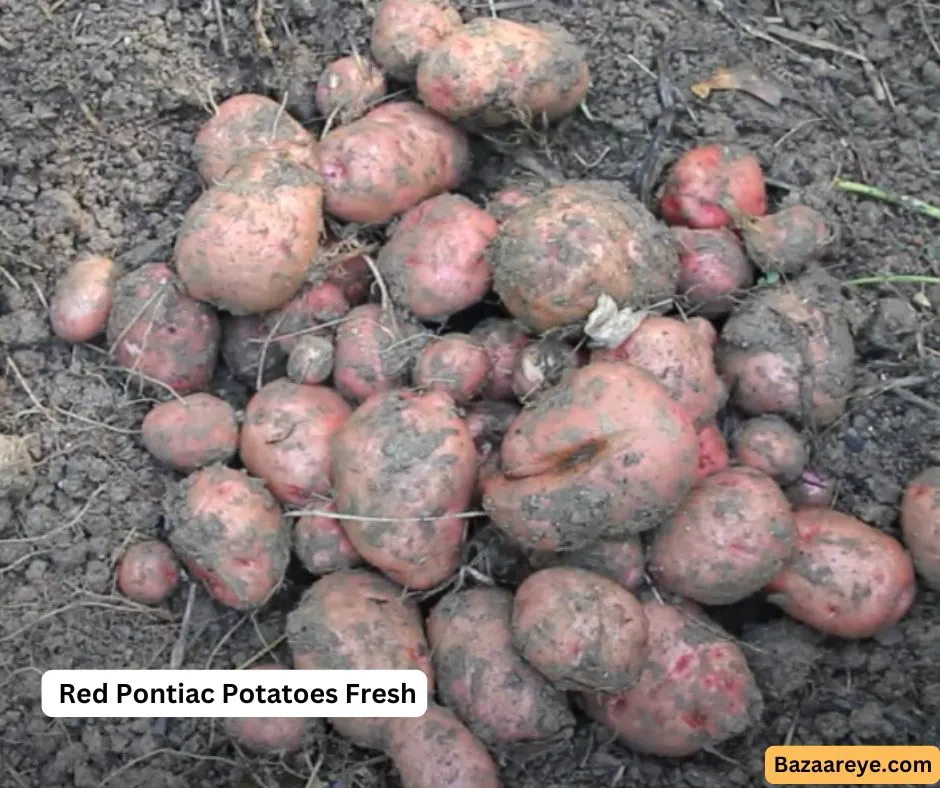Red Pontiac potatoes are a gardener’s favorite for their vibrant red skin, creamy texture, and adaptability to various growing conditions. With their intermediate maturity and reliable performance, they’re perfect for home gardeners and small-scale growers. Here’s everything you need to know about growing and enjoying these versatile spuds.
Key Plant Characteristics Red Pontiac Potatoes
Maturity: Red Pontiac potatoes are classified as intermediate to early maturity. This means they are ready to harvest relatively quickly, making them ideal for gardeners who want a faster yield.
- Growth Habit: The plants have a semi-erect to erect growth habit, making them manageable in small garden spaces.
- Foliage Cover: Expect good foliage cover, which helps suppress weeds naturally and protect the soil from drying out.
- Flower Features: Red Pontiac plants produce red-violet flowers, though these blooms appear only occasionally.
- Berry Production: This variety does not produce berries, focusing its energy on developing those delicious underground tubers.
- Sprout Characteristics: When sprouting, the light sprouts are pink, a charming prelude to their bold red-skinned tubers.

Tips for Growing Red Pontiac Potatoes
- Soil Preparation:
- Use well-draining soil rich in organic matter. Sandy loam works best, but Red Pontiacs are forgiving and can thrive in various soil types.
- Maintain a soil pH of 5.0 to 5.5 for optimal growth.
- Planting:
- Plant seed potatoes in early spring once the soil temperature reaches at least 50°F (10°C).
- Space seed pieces 12 inches apart in rows that are 30–36 inches apart.
- Care During Growth:
- Watering: Keep the soil consistently moist but not waterlogged. Water deeply, especially during tuber development.
- Hilling: Hill soil around the base of plants as they grow to protect tubers from sunlight and to encourage higher yields.
- Fertilizing: Use a balanced fertilizer high in phosphorus and potassium to support tuber development.
- Pest and Disease Management:
- Keep an eye out for common potato pests like Colorado potato beetles and aphids. Use organic insecticides or hand-pick pests as needed.
- Ensure proper crop rotation to prevent soil-borne diseases. Red Pontiacs generally have good resistance but still benefit from proactive management.
Growing Black King Potatoes: Resistance, Texture, and Flavor
Red Pontiac Potatoes: Tuber Characteristics
Red Pontiac potatoes are celebrated for their vibrant appearance and versatile tuber qualities. Whether you’re growing them for personal use or market gardening, their standout features make them a worthwhile choice. Here’s an in-depth look at the tuber characteristics that define this popular variety.
Key Tuber Characteristics
- Skin Color:
The tubers boast a striking red skin, which adds visual appeal and makes them easy to identify among other potato varieties. - Eye Color:
The red eye color blends seamlessly with the skin, enhancing the tubers’ uniform appearance. - Flesh Color:
Red Pontiacs have a primary tuber flesh color of white to yellow, offering a creamy texture and mild flavor ideal for a wide range of dishes. - Tuber Shape:
- Red Pontiacs exhibit varied shapes, ranging from round to oval, and occasionally oval to long.
- This diversity in shape makes them suitable for everything from roasting to mashing.
- Eye Depth:
- The tubers can have medium to deep eyes, but some may also feature shallow to medium eyes.
- While this variability can affect peeling ease, it does not impact the quality or flavor of the potatoes.
- Skin Texture:
The smooth skin texture makes these potatoes easy to clean and visually appealing for fresh markets or culinary presentations.
Red Pontiac Potatoes: Tubering Characteristics
Red Pontiac potatoes are a high-yielding variety loved by growers for their productivity and versatility. However, like any potato variety, understanding its tubering characteristics is crucial for achieving the best results during cultivation and storage. Here’s an overview of what you can expect.
Key Tubering Characteristics
Storage Ability:
Red Pontiacs have moderate storage ability, making them suitable for short to medium-term storage. To extend their shelf life, store them in a cool, dark, and well-ventilated area.
Yield Potential:
Red Pontiacs offer a high yield potential, making them an excellent choice for gardeners and farmers seeking a bountiful harvest. Their reliable performance ensures plenty of potatoes for fresh use or market sales.
Tuber Size:
This variety typically produces large tubers, which are ideal for various culinary applications. Their generous size is especially appreciated for mashing, baking, and roasting.

Tuber Shape Uniformity:
While Red Pontiacs are high-yielding, their tuber shape uniformity is medium. Growers may notice some variation in tuber shapes, ranging from round to oval or even elongated.
Internal Rust Spot:
Red Pontiacs are susceptible to medium to frequent internal rust spotting, a common issue in potatoes caused by uneven water availability or nutrient imbalances. Proper irrigation and soil management can help minimize this concern.
Dormancy Period:
With a medium dormancy period, Red Pontiacs strike a balance between early and long-storing varieties. This dormancy period allows growers to store them for a moderate time without premature sprouting.
Crispin Potatoes: The Resistant Variety with a Few Things to Watch Out For
Red Pontiac Potatoes: Utilization Characteristics
Red Pontiac potatoes are a popular multi-purpose variety, appreciated for their versatility in the kitchen. While they may not excel in all cooking methods, they offer unique qualities that make them a reliable choice for various culinary applications. Let’s delve into their utilization characteristics.
Key Utilization Characteristics
- Cooking Type and Texture:
Red Pontiac potatoes are classified as a fairly firm, multi-purpose type. This makes them suitable for boiling, mashing, and baking, where their creamy texture shines without becoming overly mushy. - After-Cooking Blackening:
- Red Pontiacs exhibit trace to little after-cooking blackening, a desirable trait that ensures their flesh retains an appealing color post-cooking.
- This makes them an excellent choice for dishes where presentation matters.
- Crisp Suitability:
- The variety has very poor to poor crisp suitability, and in some cases, only poor to moderate performance.
- Red Pontiacs are not ideal for making crispy potato chips, as their texture and frying characteristics don’t align well with this use.
- French Fry Suitability:
- Similar to crisps, their French fry suitability ranges from very poor to poor, with limited potential for moderate results.
- The low to medium starch content impacts their ability to achieve the desired crispiness and fluffiness in fries.
- Frying Color:
- When fried, Red Pontiacs produce a medium to dark color, which may not meet the expectations for golden fries or chips. This characteristic is another reason they are less suited for frying purposes.
- Dry Matter and Starch Content:
- The dry matter content ranges from low to medium to medium to high, which varies depending on growing conditions.
- The starch content is shallow to low to medium, giving the potatoes their creamy texture but limiting their suitability for frying.
Best Culinary Uses for Red Pontiac Potatoes

Despite their limitations for frying and crisps, Red Pontiacs excel in other cooking methods:
Baking: Their large size and smooth skin make them an excellent option for baked potatoes.
Boiling: Their fairly firm texture holds up well, making them perfect for potato salads or soups.
Mashing: The creamy flesh creates a smooth and satisfying mash with minimal effort.
Growing Drayton Potatoes: Strengths, Challenges, and Tips for Success
Red Pontiac Potatoes: Resistance to Fungal Diseases
When growing Red Pontiac potatoes, understanding their resistance to fungal diseases is essential for managing plant health and ensuring a successful harvest. Here’s a detailed look at how this variety performs against common fungal challenges.
Key Resistance Levels
Late Blight Resistance:
Tubers: Resistance ranges from low to medium to high, with variability depending on growing conditions and management practices. Laboratory tests suggest a low to medium resistance.
Foliage: Resistance to late blight on foliage is low to medium, with the potential to reach medium to high under favorable conditions. However, it is generally weaker than tuber resistance, making proactive disease control crucial.
Stem Canker (Rhizoctonia solani):
Red Pontiacs are very low in resistance to stem canker, making them highly susceptible. Good soil management and crop rotation are essential to minimize risks.
Wart Disease (Synchytrium endobioticum):
This variety is susceptible to wart disease, a serious fungal issue in potatoes. It is advisable to avoid planting Red Pontiacs in areas with a history of this pathogen.
Gangrene (Phoma foveata):
Red Pontiacs display a high resistance to gangrene, a significant advantage for storage and long-term tuber health.

Dry Rot (Fusarium spp.):
Resistance to dry rot is medium, which provides moderate protection during storage. Proper curing and storage conditions can further reduce the risk of infection.
Duke of York Potatoes: A Classic Early Harvest with Unique Needs
Red Pontiac Potatoes: Resistance to Viral Diseases
Viral diseases can significantly impact potato crops by reducing yields and affecting tuber quality. Red Pontiac potatoes have varied levels of resistance to common potato viruses, making it important for growers to implement management strategies to minimize viral risks.
Key Viral Disease Resistance Levels
Potato Virus A (PVA):
Resistance to PVA is low to low to medium, leaving this variety vulnerable to infection. Effective prevention is necessary to avoid yield losses.
Potato Virus X (PVX):
Resistance to PVX is low to medium, meaning infections are possible but may not always result in severe symptoms.
Potato Virus Y (PVY):
Resistance to PVY (strain not specified) varies from low to medium to high, depending on the specific strain and growing conditions. This variability makes it essential to monitor plants closely for signs of PVY infection.
Resistance to PVY-N (necrotic strain) is low, indicating heightened susceptibility to this strain, which can cause significant damage.
Potato Leaf Roll Virus (PLRV):
Red Pontiac potatoes exhibit low to medium resistance to PLRV. Infections can lead to reduced tuber size and yield, as well as rolling and yellowing of leaves.
Red Pontiac Potatoes: Resistance to Pests
Pest resistance is an important factor when cultivating potatoes, as pests can significantly impact plant health, tuber yield, and quality. For Red Pontiac potatoes, resistance to nematode pests like Globodera rostochiensis (potato cyst nematode) is limited, requiring growers to adopt effective pest management strategies.
Key Pest Resistance Levels
Resistance to Globodera rostochiensis Race 1:
Red Pontiac potatoes have low resistance to G. rostochiensis race 1. This means the variety is susceptible to infestations, and populations of this nematode can thrive without adequate control measures.
Resistance to Globodera rostochiensis Race 5:
Resistance to G. rostochiensis race 5 is very low to low, making Red Pontiacs highly vulnerable to this pest. Growers in areas where this race is prevalent need to be especially vigilant.
Red Pontiac Potatoes: Environmental Stress Tolerance
Potatoes often face a range of environmental stressors that can impact growth, yield, and quality. Red Pontiac potatoes stand out for their impressive drought resistance, making them a reliable choice in regions with limited water availability or erratic rainfall patterns.

Key Environmental Stress Factor
- Drought Resistance:
- Red Pontiac potatoes demonstrate high to very high drought resistance, enabling them to perform well under dry conditions.
- Their ability to tolerate reduced water availability ensures consistent tuber production, even in challenging climates.
Home Guard Potatoes: The Essential Guide to Planting, Growing, and Harvesting
Benefits of High Drought Resistance
Cost Savings: Reduced water requirements can lower irrigation costs, benefiting both commercial farmers and home gardeners.
Reduced Irrigation Needs: Red Pontiacs are less dependent on frequent watering, making them ideal for areas with water restrictions or where irrigation infrastructure is limited.
Stable Yields in Dry Seasons: Their drought tolerance minimizes yield losses during dry periods, offering growers more predictable harvests.
Conclusion
Red Pontiac potatoes are a versatile and hardy variety with notable strengths and some challenges. They offer excellent drought resistance, making them ideal for dry regions, and high yield potential with large, smooth-skinned tubers. While their cooking versatility shines for boiling, baking, and mashing, they are less suitable for frying. Moderate resistance to certain diseases like dry rot and gangrene is offset by vulnerabilities to pests, viral diseases, and stem cankers. With proper soil management, crop rotation, and preventative care, this multi-purpose potato variety can thrive and produce a satisfying harvest.
4 thoughts on “Red Pontiac Potatoes: Versatility and Resilience in the Kitchen and Field”